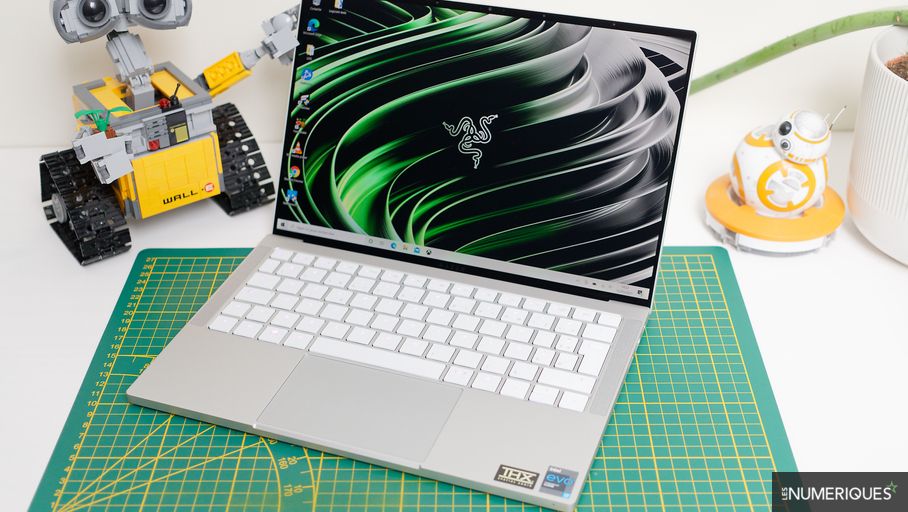There is an atmosphere of deja vu when looking at Razer’s Book 3. Its one-piece aluminum cover is clearly reminiscent of a particular MacBook Pro. However, Book 13 is more congruent with the flat surfaces and the four rounded corners well.
Once it’s not customized, here we’re making use of a very discreet design on the part of Razer. © Digital
Opening is done with one finger. Be careful, the cover is magnetic, so you should help. Once opened, Book 13 reveals a 13.5-inch display with ultra-narrow bezels, which raises the occupancy rate, according to our calculations, to just over 90%.
The keyboard between the two headphones is made up of white keys. It is clearly RGB backlit and can be customized as desired thanks to Razer Synapse software. Additionally, the Razer Chroma will adapt the backlight according to the game you’re playing in order to clearly distinguish between switches and their functions.
Razer software recognizes applications and changes keyboard backlight. © Digital
Appropriately sized, the touchpad is very responsive and we had no problem implementing various gestures for Windows 10. Even drag and drop is executed with ease.
Connections are distributed on each side of the chassis, with the Thunderbolt 4 port, HDMI port and microSD card reader on the right. On the left is a second Thunderbolt port, accompanied by a USB port and combo microphone / headphone jack.
The network portion is provided by the Intel AX210 chip, thus introducing wifi 6 (2400MB / s) and Bluetooth 5.2 to the Razer Book 13. The webcam features a 720p definition and is compatible with its infrared accessories. The quality of this webcam leaves much to be desired, but the face recognition to unlock your session works without a hitch.
The ultrabook is cooled by two fans located on both sides of the chassis. Under the chassis, there are two large openings to ensure the supply of fresh air, and the hot air is drawn into the section at the level of the hinge.
The fan openings contrast with the rest of the design. © Digital
After 15 minutes of coding in HandBrake, we observed a maximum temperature of 44 ° C just above the keyboard. At the level of the latter, the peak temperature is located in the center – we can also guess the presence of fans. The touchpad stays cool in all conditions at 32 ° C.
The ventilation does not appear to have been improved. © Digital
Although we don’t have much to mistake Razer Book 13 from a thermal standpoint, it errs in terms of noise pollution. Even when the computer is not in use, the ventilation remains active most of the time, although the noise level is low, but still noisy. Just surfing the internet or watching a video should be possible without ventilation. After 15 minutes of encryption, the ventilation is good and a real acoustic with a reading of 37dB and 50cm from the keyboard. So it’s a very audible breath. We are definitely far from computer harassment the gamesBut the phenomenon has to be taken into account.
Small Scalability, Lots of Seals: Razer doesn’t like DIY enthusiasts. © Digital
Dismantling the Razer Book 13 isn’t much of a problem. Once you’ve removed the ten Torx screws, you must loosen the two lugs on the back of the touchpad and finally gently lift the housing to bring out the third lug on the motherboard.
The evolution possibilities of the Razer Book 13 are very limited, because only the battery and SSD can be removed. We also note that everything that is interchangeable is equipped with bolt-level seals. Apparently, Razer really doesn’t want you to put your fingers inside his book 13.
Our Razer Book 13 test is powered by an Intel Core i7-1165G7 processor with crossover quad cores that can reach 4.7GHz. Everything is accompanied by 16 GB of RAM and 256 GB of SSD.
Remember to activate performance mode in Razer Synapse to take full advantage of the Core i7-1165G7. © Digital
The Intel Core i7-1165G7 is now a processor we know so well because the Razer Book 13 is the seventh machine in our hands to be equipped with. As our testing progressed, we noticed that its performance depends primarily on the settings applied by the manufacturer. Thus in the Acer Swift 3x, you get a score of 74 while in the HP Specter x360, it only peaks at 49. The Razer Book 13 scores a 68th benchmark with the Core i7-1165G7 by enabling the performance setting in Synapse, Razer’s management software.
Oddly, the Razer Book 13 is basic in balanced mode which limits the processor to a TDP of 20 watts, while Razer planned for a TDP of 35 watts. It will be necessary to switch to performance mode to get the latter. Thus our index has evolved from 60 in balanced mode to 68 in performance mode. This is especially useful for multi-threaded applications.
In our Non-Gamer PC game, Note and observe And the Diablo 3, Razer Book 13 does it excelent. Under Diablo 3 With all the details set to maximum Full HD resolution, we found an average of 63 frames per second, while less than Note and observe We get 68 fps with detail set to a minimum.
Our Edition of Book 13 IPS touch panels with a width of 1920 x 1200 pixels. As we saw a bit above, the occupancy rate is close to 90% thanks to the 16:10 format and very fine borders everywhere.
Occupancy rate of 90% and a figure of 16:10 is tangible. © Digital
Under our probe, IPS board is of good quality. Thus, Delta E is much lower than 3 with 1.3 readings. The contrast is slightly lower than the average of computers tested with 1450: 1 – nothing alarming, thus – and the temperature is slightly higher than an ideal video standard (6550 K) with a measurement of 6721 K. The plate residue has an average of 23 ms. Despite its glossy finish, the Razer Book 13 has a fairly low reflection of 25.1%. So the anti-reflective treatment applied by Razer is of very good quality. Glossy tiles without processing usually get a value of 50%, while good glossy tiles claim around 15%.
Panel brightness is also well above average (352 cd / m2) with a reading of 452 cd / m2. Note that Book 13 is equipped with an ambient light sensor that allows changing that on the board.
From left to right, gamma curve, color temperature, and delta E. © Les Numériques
Do not bypass the lock switch. Transformation. © Digital
Razer had a good idea to place the speakers next to the keyboard, eliminating the need to cover them with your hands when typing, or even relying on the cradle for sound quality. Don’t be fooled by the size of the grilles as the speakers only occupy the bottom third. Listen, the sound is correct, the bass is absent as usual, and at high volume the quality is no longer there. Distortion is also highlighted at full size.
The headphone out is capable of accommodating monitors. © Digital
On the other hand, the headphone output of the Razer Book 13 is very well made with a high output level of 230 mVRMS, which is ideal for connecting monitors. The dynamic range and distortion are average, with interference below.
The Razer Book 13 measures 29.5 x 19.8 cm in size, which is slightly smaller than an A4 sheet and 1.5 cm in thickness. It weighs 1.38 kg on our scale and the weight of the charger is 65 watts with mains cable 309 grams. Obviously, with these measurements, the Razer Book 13 will fit in any backpack. However, we are sorry that there is a main cable and we would have preferred the block type charger, especially since the charger itself is very compact.
The charger is compact, and the mains cable is much lower. © Digital
Equipped with a 55W battery, the Razer Book 13 achieves 8 hours 47 minutes of autonomy with our usual protocol (Netflix under Chrome with 200 cd / m² brightness and headphones plugged in at 50% volume). Comfortable autonomy you should be able to extend a little by switching to Synapse’s power saving mode to last all day.

“Certified gamer. Problem solver. Internet enthusiast. Twitter scholar. Infuriatingly humble alcohol geek. Tv guru.”





